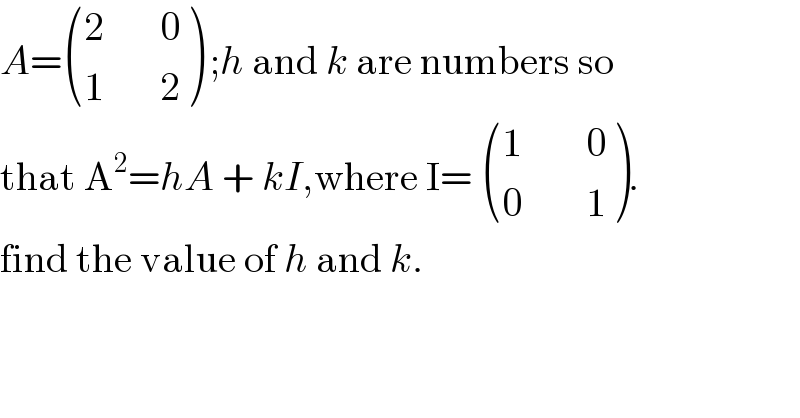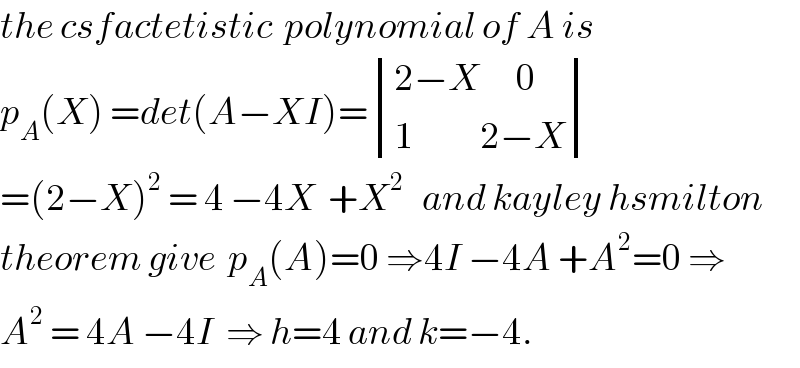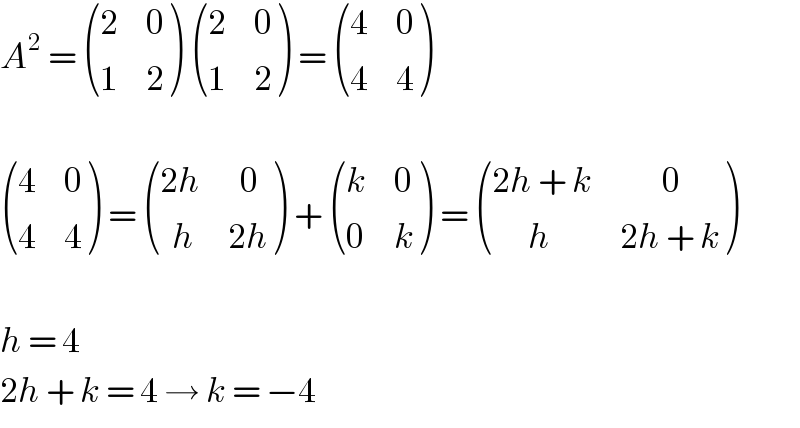Question Number 32869 by Rio Mike last updated on 04/Apr/18

$${A}=\begin{pmatrix}{\mathrm{2}\:\:\:\:\:\:\:\mathrm{0}}\\{\mathrm{1}\:\:\:\:\:\:\:\mathrm{2}}\end{pmatrix}\:;{h}\:\mathrm{and}\:{k}\:\mathrm{are}\:\mathrm{numbers}\:\mathrm{so} \\ $$$$\mathrm{that}\:\mathrm{A}^{\mathrm{2}} ={hA}\:+\:{kI},\mathrm{where}\:\mathrm{I}=\:\begin{pmatrix}{\mathrm{1}\:\:\:\:\:\:\:\:\mathrm{0}}\\{\mathrm{0}\:\:\:\:\:\:\:\:\mathrm{1}}\end{pmatrix}. \\ $$$$\mathrm{find}\:\mathrm{the}\:\mathrm{value}\:\mathrm{of}\:{h}\:\mathrm{and}\:{k}. \\ $$
Commented by abdo mathsup last updated on 09/Apr/18

$${the}\:{csfactetistic}\:\:{polynomial}\:{of}\:{A}\:{is} \\ $$$${p}_{{A}} \left({X}\right)\:={det}\left({A}−{XI}\right)=\begin{vmatrix}{\mathrm{2}−{X}\:\:\:\:\:\:\mathrm{0}}\\{\mathrm{1}\:\:\:\:\:\:\:\:\:\:\:\mathrm{2}−{X}}\end{vmatrix} \\ $$$$=\left(\mathrm{2}−{X}\right)^{\mathrm{2}} \:=\:\mathrm{4}\:−\mathrm{4}{X}\:\:+{X}^{\mathrm{2}} \:\:\:{and}\:{kayley}\:{hsmilton} \\ $$$${theorem}\:{give}\:\:{p}_{{A}} \left({A}\right)=\mathrm{0}\:\Rightarrow\mathrm{4}{I}\:−\mathrm{4}{A}\:+{A}^{\mathrm{2}} =\mathrm{0}\:\Rightarrow \\ $$$${A}^{\mathrm{2}} \:=\:\mathrm{4}{A}\:−\mathrm{4}{I}\:\:\Rightarrow\:{h}=\mathrm{4}\:{and}\:{k}=−\mathrm{4}. \\ $$
Answered by Joel578 last updated on 05/Apr/18

$${A}^{\mathrm{2}} \:=\:\begin{pmatrix}{\mathrm{2}}&{\mathrm{0}}\\{\mathrm{1}}&{\mathrm{2}}\end{pmatrix}\:\begin{pmatrix}{\mathrm{2}}&{\mathrm{0}}\\{\mathrm{1}}&{\mathrm{2}}\end{pmatrix}\:=\:\begin{pmatrix}{\mathrm{4}}&{\mathrm{0}}\\{\mathrm{4}}&{\mathrm{4}}\end{pmatrix} \\ $$$$ \\ $$$$\begin{pmatrix}{\mathrm{4}}&{\mathrm{0}}\\{\mathrm{4}}&{\mathrm{4}}\end{pmatrix}\:=\:\begin{pmatrix}{\mathrm{2}{h}}&{\:\:\mathrm{0}}\\{\:\:{h}}&{\mathrm{2}{h}}\end{pmatrix}\:+\:\begin{pmatrix}{{k}}&{\mathrm{0}}\\{\mathrm{0}}&{{k}}\end{pmatrix}\:=\:\begin{pmatrix}{\mathrm{2}{h}\:+\:{k}}&{\:\:\:\:\:\:\:\mathrm{0}}\\{\:\:\:\:\:\:{h}}&{\mathrm{2}{h}\:+\:{k}}\end{pmatrix} \\ $$$$ \\ $$$${h}\:=\:\mathrm{4} \\ $$$$\mathrm{2}{h}\:+\:{k}\:=\:\mathrm{4}\:\rightarrow\:{k}\:=\:−\mathrm{4} \\ $$
